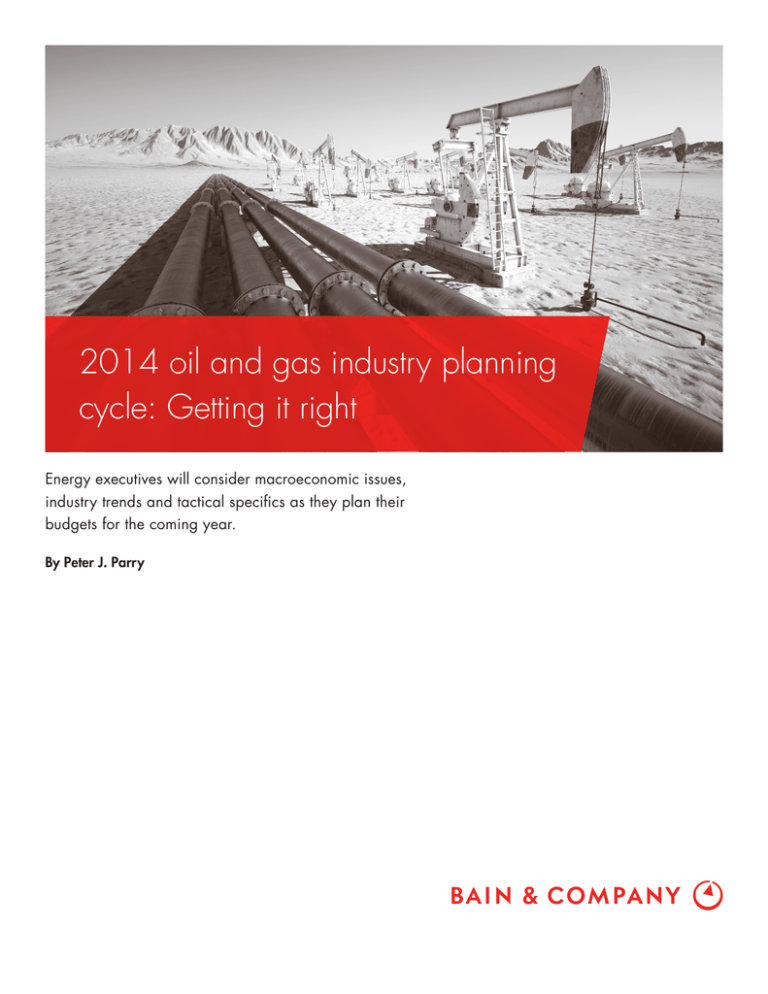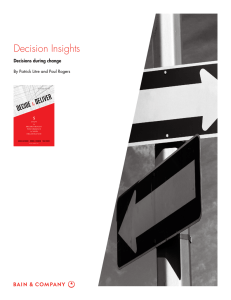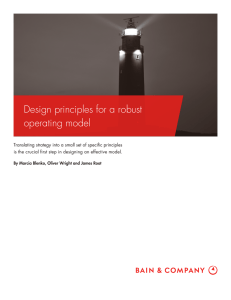
2014 oil and gas industry planning
cycle: Getting it right
Energy executives will consider macroeconomic issues,
industry trends and tactical specifics as they plan their
budgets for the coming year.
By Peter J. Parry
Key contacts in Bain’s Global Oil & Gas practice
Europe,
Middle East
and Africa: Lars Jacob Boe in Oslo (larsjacob.boe@bain.com)
Luca Caruso in Moscow (luca.caruso@bain.com)
Juan Carlos Gay in London (juancarlos.gay@bain.com)
Christophe de Mahieu in Dubai (christophe.demahieu@bain.com)
Roberto Nava in Milan (roberto.nava@bain.com)
Peter Parry in London (peter.parry@bain.com)
Tiziano Rivolta in Milan (tiziano.rivolta@bain.com)
Natan Shklyar in Moscow (natan.shklyar@bain.com)
Luis Uriza in London (luis.uriza@bain.com)
Americas: Asia-Pacific:
Riccardo Bertocco in Dallas (riccardo.bertocco@bain.com)
Pedro Caruso in Houston (pedro.caruso@bain.com)
Mark Gottfredson in Dallas (mark.gottfredson@bain.com)
Eduardo Hutt in Mexico City (eduardo.hutt@bain.com)
Jorge Leis in Houston (jorge.leis@bain.com)
Rodrigo Mas in São Paulo (rodrigo.mas@bain.com)
Ethan Phillips in Houston (ethan.phillips@bain.com)
José de Sá in São Paulo (jose.sa@bain.com)
Sharad Apte in Bangkok (sharad.apte@bain.com)
Francesco Cigala in Kuala Lumpur (francesco.cigala@bain.com)
John McCreery in Singapore (john.mccreery@bain.com)
Brian Murphy in Perth (brian.murphy@bain.com)
Peter J. Parry is a partner with Bain & Company in its London office. He is a
vice president and leads the firm’s Global Oil & Gas practice.
Copyright © 2013 Bain & Company, Inc. All rights reserved.
2014 oil and gas industry planning cycle: Getting it right
As commercial and national oil and gas companies begin
their annual planning cycles in September, they will
assess the macro business environment and make careful
assumptions about the industry and their companies’
positions in it. These insights will define the coming year’s
performance targets, confirm priorities and set board and
shareholder expectations. Done well, they serve as a
robust backdrop for establishing effective plans, budgets
and rolling five-year operating plan updates.
with the deteriorating conditions of the major developing
economies. For the current planning horizon, we expect
the volatility in China’s growth to continue, and it will
be amplified through the many upstream trading partner
countries that have relied on sustained China dynamism
for their own growth. While the effect of a stabilizing
West and a more uncertain East may net overall growth,
higher volatility combined with a still-low cost of capital
environment will likely make conditions ripe for large,
short-term swings in the oil industry. Yet these notes of
caution are a passing veil of uncertainty as midterm GDP
growth and a sustained low cost of capital environment
create a positive medium- to longer-term future for the
oil and gas industry.
As in previous years, Bain & Company offers a critical
checklist of 10 key issues, to inform the 2014 oil and gas
planning and budgeting cycle. The list covers macroeconomic trends, industry themes and specific tactical
considerations. We recommend using this kind of struc­
tured framework to challenge thinking and ensure a
highly effective 2014 planning process, contributing to
high-quality, accurate results.
1. Low real interest rates. 2014 plans should take into
account the likelihood that the business world will see a
continued period of low-cost capital, driven by low real
interest rates. The inevitable end of the Federal Reserve’s
emergency measures does not alter the fundamentals
driving the low real interest rate environment and
should be factored in only for tactical considerations. Oil
and gas companies generally continue to enjoy strong
balance sheet positions with gearing below 30%, while low-
A. Macroeconomic trends
Global macroeconomic risks have shifted somewhat as
the modest stabilization in the major advanced economies,
including the US1 and Western Europe,2 has contrasted
Figure 1: Unfulfilled potential in North Sea oil production assets
Monthly average production, barrels of oil per day
300,000
Field delivered at 83% of full potential over last
five years. Monthly production highly volatile.
200,000
100,000
0
2008
2009
Full potential
2010
2011
Moving average (last 12 months)
Source: DECC; Bain’s OE Evaluation Tool
1
2012
Actual
2013
2014 oil and gas industry planning cycle: Getting it right
cost capital offers additional investment and expansion
opportunities. More ambitious investors and governments
may also begin to progressively lower their investment
hurdle rates, pushing oil companies’ capital spending
levels even higher and increasing national oil companies’ (NOCs’) appetites for acquisition. For the oil
majors with lagging profit-to-equity ratios, a growth
push is one route to closing the gap between them and the
pharmaceutical and technology sectors3 as priority shifts
toward top-line revenue growth.
The outlook is not great overall and offers opportunities
for some to establish real differentiation in the quality
of their next-generation growth projects.
3. Capabilities and capacity. Hiring and retaining the
best people and filling capability shortages are paramount
issues. Companies with clear staffing strategies will gain
significant competitive advantage and greater confidence in their ability to deliver. We see too many companies
that don’t know how many staff they have in key technical
disciplines and don’t have a good-enough estimate of what
is needed for the next five years.
2. The new normal of political risk. The shifting political
landscape is an aspect of the oil industry that has historically felt manageable. Tensions come and go. However,
in 2014 the industry will have to contend with a new
administration in Australia; energy reforms in Mexico
and India; difficulties in Egypt, Nigeria and now Syria;
and perhaps strengthening energy alliances among
Russia, China, Brazil and the Caspian countries. The
China Sea region continues to be an area of low-grade
tension, which may be exacerbated by a more resurgent
Japan combined with a potentially massive transition
China may be facing.
Growth leaders are building detailed plans to strengthen
their talent pools and improve their capabilities into their
budget processes. Specialist skills are more valued today
than at any other time in the past two decades. ExxonMobil, Shell and BP have all moved their upstream
operating models to technically thematic organizations—a
shift from functional organizations. Some US shale gas
players, such as Hess and Chesapeake, are moving to
focused asset-based models in an attempt to get a better
handle on costs and build specific technical needs. This
will allow the development of strong, differentiated core
capabilities, which is a prerequisite for sustainable growth.
We expect more companies to follow this trend in 2014.
Few companies have structured processes for embedding
short-term disruptive political risk into their annual
planning processes. Yet this level of sophistication is
exactly what oil companies need in an uncertain environment. We are still likely to see some companies disadvantage themselves by planning to increase performance
targets and investment hurdle rates in the face of unstable
political settings, instead of creating plans that explicitly
deal with a range of possible political developments.
4. Inflation. Growth areas like Brazil, Australia and the
Middle East, as well as the unconventional activities in
the US, are seeing annual energy industry cost inflation
rates of 10% to 15% in some equipment and services.
Planning budgets often assume that increased spending
will generate more activity, but Bain’s analysis finds that
many companies are spending more on operations without corresponding increases in activity and, more important, production volumes. Quite a few companies have
structured productivity and cost improvement programs
(Occidental), restructuring plans (Hess) or project cost
reviews (Chevron’s review of its huge Gorgon LNG project
in Western Australia) under way. Here, too, we anticipate
that many more will need to do this in 2014.
B. Oil and gas industry themes
In 2013, we called out three significant oil industry planning
themes: capabilities, inflation and price volatility. These
are even more important to the 2014 planning cycles of
oil majors, national oil companies, oil independents and
the oilfield services sector. The first two, capabilities
and inflation, dragged down results in the first half of 2013,
suggesting they were underplayed in last year’s plans. Price
volatility, while not dramatic,4 was cited by many as a
surprise in the first- and second-quarter 2013 results.
5. Oil and gas price volatility. Price uncertainty continues
to challenge energy companies as they estimate their net
incomes and affordability of capital project budgets.
Several companies, including ExxonMobil, Shell and
ConocoPhillips, referenced this uncertainty in their 2013
second-quarter results. Lower price realization is a challenge when many companies are still running “marker”
gas or crude price in their budgeting exercises.
These themes are joined in 2014 by generally weaker
capital project inventories beyond 2017. Where will the
next generation of step-change growth come from, as
the industry delivers the current crop of major projects?
2
2014 oil and gas industry planning cycle: Getting it right
Figure 2: Maintenance backlogs among typical oil production sites
Maintenance backlog as a percentage of estimated yearly maintenance man hours at the end of the quarter
14.0%
Year 2 Average Backlog = 10.6% (5.5 weeks)
12.0
Year 1 Average Backlog = 8.8% (4.6 weeks)
10.0
8.0
6.0
4.0
2.0
0
Quarter 1
Quarter 2
Quarter 3
Quarter 4
Quarter 5
Quarter 6
Quarter 7
Quarter 8
Source: Bain analysis
6. Longer-term project pipeline quality. With so many
large developments and expansion programs scheduled
to complete by 2017, the industry must now define the
next generation of projects. Gas export terminals in the
US, complex East African gas, ultra-deepwater and Arctic
drilling, along with a new round of refinery upgrades
to meet new fuel specifications—it’s hard to see these all
as high-return projects. We expect many companies will
return to mature sites and look for the missed oil, tapping
improved recovery techniques, including advanced seismic sensing, digital oilfield applications and the next
generation of drilling technology advances. The industry
could in 2014 start to signal a move away from megaprojects, to large reactivation and infill programs upstream
as well as selective expansions around advantaged sites
in the downstream.
7. Exploration focus. Exploration is difficult at the
best of times, as the license round schedule, drilling
success rates, and the costs and availability of rigs all
introduce uncertainty. For larger players, materiality
and maturation speed are constant concerns, which
is why we have seen many companies now quoting
resource addition annual performance in addition
to proven (P1) reserve additions. To grow 100,000
barrels of oil equivalent (BOE) per day, producers
need to consistently find an extra 35 million to 45 million
BOE per year. For the supermajors and large NOCs to
sustain production, finding 1 billion to 1.5 billion BOE
a year is the challenge.
C. Tactical specifics
•
Big gas (East Africa, Australia and the eastern
Mediterranean);
•
Re-exploration: Going back to mature provinces with
improved seismic-while-drilling technology and
knowledge (Norway, UK and the Gulf of Mexico);
The priority exploration themes for 2014 seem to be
the following:
The planning challenge specific to each company’s circumstances and portfolio will vary, but most will have exploration, gas, projects and operational performance on
their planning priorities lists.
3
2014 oil and gas industry planning cycle: Getting it right
•
Deepwater oil (Brazil, West Africa and a full restart
in the US’s Gulf of Mexico);
•
Onshore oil (East Africa, India, California and Egypt);
•
Unconventional oil and gas (US, Argentina and
Australia).
six months will see lumpy performance rather than a
smooth ramp-up, as the facility transfers from project
to operations.
Unconventional projects are quite different in nature,
more akin to a long-running manufacturing program
that has a constantly moving work site. For planning
effectiveness, the measure is how many wells can we
complete and hook up, how quickly and at what unit cost.
For the 2014 plan, it will be vital to know if these criteria
are escalating, steady or declining.
The number of focus areas required by an oil company
is largely a function of size. But with exploration budgets
of $500 million per year for even the independents and
as much as $5 billion per year or more for the supermajors,
there seems to be no shortage of investment dollars
targeting emerging trends and new opportunities.
10. Realistic operational delivery. The operational reliability of the oil and gas industry continues to be a
major challenge and a huge opportunity to realize value.
For example, in the North Sea the average oil production
asset performs well below its theoretical potential and
has a large backlog of maintenance work (see Figures
1 and 2). From a planning perspective, it is critical to
have a clear view of historical performance, as well as
reasons to expect stronger or weaker future delivery and
the extent to which planned programs and interventions
will increase operational performance.
8. Gas. Planning for one to five years in gas—once a
stable, long-term part of the portfolio—has taken on a
challenging degree of uncertainty. Unconventional gas
in the US has caused major swings in market prices and
the value of gas assets. The most recent of these include
the write-downs by many companies that had built up
big resource positions, such as Anadarko, BHP Billiton,
Encana, Noble, Statoil, Shell and Total; cost escalation
for mega offshore projects, as experienced by Chevron
Australia; and large new discoveries in East Africa, India,
Argentina, the eastern Mediterranean and Australia.
Summary: Getting 2014 right
At Bain, we see a greater premium than ever in getting
forecasts and guidance right, not only for internal performance management but also for IOCs to meet stock
market requirements and for NOCs to contribute to
national budgets. The lower profit-to-equity ratios in oil
and gas indicate a performance gap between this sector
and other major commercial sectors—which has as
much to do with planning as with delivery.
Gas remains a very strong part of the mix and will drive
a large part of the volume growth for the international
oil companies (IOCs) over the next decade. But project
delivery is likely to be slow, with commercialization subject to greater gas-to-gas competition. The best projects
will still yield solid returns and support growing demand.
But it is more important than ever to hold “advantaged”
assets to deliver strong results.
Whenever possible, the approach to planning should
focus on the quality of information and sensitivity analysis around what are often P50 numbers—that is, those
with at least a 50% confidence level of being commercially recoverable. It is also important to have a realistic
view on timing for new projects as well as the upside to
be found in mature assets. With a good checklist as a
prompt, 2014 planning could be the best yet.
9. Major projects start up. Major conventional projects
face two main performance challenges, in addition to
meeting cost expectations, of course. First, will the
project meet its start-up date? Second, will it perform to
expectations? Recent history suggests that the larger the
project, the more susceptible it is to slippage. Once up
and running, there is a strong likelihood that the first
1
2
3
4
US GDP in Q2 2013 was 2.5% compared with that of Q2 2012, which was 2.0%.
GDPs for Germany, UK and France in Q2 2013 were between 2% and 3%, up from negative numbers in Q2 2012.
Source: Datastream, 2013 profit-to-equity ratios for the pharmaceutical (18.9), technology (18.6) and oil and gas production (10.1) sectors worldwide.
Source: Datastream; The price of crude oil has fluctuated between $86 and $108 to date in 2013; gas prices have generally improved.
4
The 2014 planning and budgeting cycle checklist
Oil and gas companies should address the following macroeconomic trends, industry themes and
tactical considerations as they plan for the coming year.
What are the macroeconomic trends we must plan for?
1. Low real interest rates. What will a period of sustained low-cost capital enable us to do?
2. The new normal of political risk. How can we plan better for short-term disruptive political risk?
Which industry themes will be most critical in the coming year?
3. Capabilities and capacities. How can we strengthen our talent pool and organize more effectively?
4. Inflation. How should we account for sector inflation?
5. Oil and gas price volatility. How can we plan effectively, given the volatility in prices?
6. Longer-term project pipeline quality. What plans should we make to extend growth beyond the
completion of major projects beyond 2017?
What tactical considerations are most important in our plans for 2014?
7. Exploration focus. Where will we focus, and how will we ensure adequate reserves?
8. Gas. What role will gas play in our portfolio?
9. Major projects start-up. How can we ensure that projects complete on time and deliver on their
expected performance goals?
10.Realistic operational delivery. What effect will operational improvement programs have on
our performance?
Shared Ambition, True Results
Bain & Company is the management consulting firm that the world’s business leaders come to when
they want results.
Bain advises clients on strategy, operations, technology, organization, private equity and mergers and acquisitions. We develop
practical, customized insights that clients act on and transfer skills that make change stick. Founded in 1973, Bain has 48 offices
in 31 countries, and our deep expertise and client roster cross every industry and economic sector. Our clients have outperformed
the stock market 4 to 1.
What sets us apart
We believe a consulting firm should be more than an adviser. So we put ourselves in our clients’ shoes, selling outcomes, not
projects. We align our incentives with our clients’ by linking our fees to their results and collaborate to unlock the full potential
of their business. Our Results Delivery® process builds our clients’ capabilities, and our True North values mean we do the right
thing for our clients, people and communities—always.
For more information, visit www.bain.com









